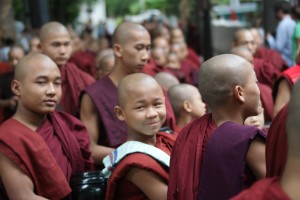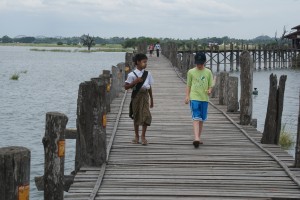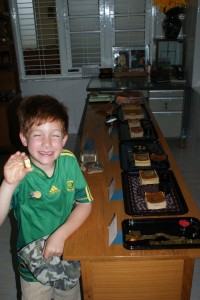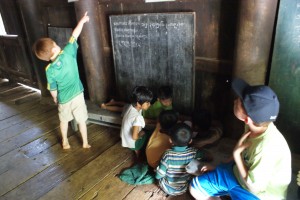Mandalay is such a romantic name – but it’s not the most attractive city in Myanmar. Nevertheless, it can keep you busy for days and we had a really good time there. It is a very manageable city – not too many crowds, not too much traffic and easy to walk around.
We checked into the Mandalay City Hotel, a good business class hotel right downtown – it had everything we needed – and a pool as well.
On our first night we ventured out into the dimly lit streets to look for the famous Chapati stand. We had read reviews in Lonely Planet and it is very well known. It’s also extremely busy. It is an outdoor restaurant – with small tables and chairs strewn on the sidewalk. Every single table was full, and for the first twenty minutes we could only watch the action, which centered around a group of people furiously rolling dough into very thin thin pancake sized pieces, throwing them into a tandoor-type oven, and then, within a minute or two, flipping steaming freshly baked chapatis onto dozens of plates which were then carried off to the waiting tables. This was clearly a Muslim place, as most of the patrons were Muslim, and we figured it was so full as it was Ramadan and this was clearly a good place to break the fast.
For those seeking a comfortable and quiet dinner, this is not the place. Eventually, we managed to squeeze around a table which already had two men eating, and scrunched up, we ate our meal, almost in the street. It’s not only chapatis – it’s also curries, soups, rice – and everything we ordered was excellent and incredibly cheap. Our family of five ate for $5.
While we were eating an entrepreneurial artist approached us and immune to our protests, began pulling out his paper and paint and started painting scenes of Myanmar daily life in front of us. His work was so good that in the end we bought five small paintings from him, each for about $2.
The next morning we toured some of the handicraft workshops of Mandalay.
The city is famous for its crafts, and there is a huge variety, all done by hand. Gold leaf, embroidery, woodcarving, bronze making, marble sculptures – we saw it all. It was fascinating – and the techniques and processes have been around for ever. At the gold leaf workshop, where they pound an ingot of pure gold into paper thin leaves that are measured in microns, they use a clock that is made out of a coconut – when it fills with water, fifteen minutes has passed. The kids were enthralled. It turns out that Myanmar produces many of the handicrafts that are sold in Thailand as Thai crafts – tapestries embroidered with sequins, carvings and more. We saw huge sculptures that were going to be shipped off to China, Europe and other places across the world.
Our next stop was a monastery at Amarapura, just out of the city, which has become a big tourist draw. Almost every Myanmar child , whether boy or girl, spends some time in a monastery. This is a very big committment by their parents who have to pay for the “uniform” , bowl, etc. Some kids stay for just a week, others for months, some for years, and some their whole lives. Each monk has a begging bowl, and every morning throughout the country you will see monks (some older, some younger) going from store to store and restaurant to restaurant asking for some food, which is then put into their bowls. They take this back to the dining room at the monastery where at about 10am they eat their main meal of the day together with all teh other monks. The monastery has its own kitchens, to make sure that everyone eats well. In fact, we asked our guides why we didn’t see any beggars around, and their reply was that in Buddhism, nobody goes hungry – the monastery will always take care of the poor.
So, at around 10am, we stood with plenty of other tourist at the entrance of the dining room waiting for the monks to file in. It was an extraordinary sight, though one wonders how they feel about being watched over and photographed while they eat. We did notice that many foreigners have made donations to the monastery, so perhaps that is the payoff.
The kids found this all really interesting – some of the monks were little – five years old maybe. So our kids could only wonder at the kind of life that these children were leading, and most probably, the little kid novice monks were looking at us and wondering the exact same.
We carried on to the famous U Bein bridge. The bridge is the longest teak bridge in the world and it is a few hundred years old. It is featured on most postcards of Myanmar, as well as on the cover of the current Lonely Planet guide. We knew that it is supposed to be best at sunset, but this was the rainy season, and most sunsets are obscured by heavy clouds, so we decided to go during the day. The bridge was a bit disappointing – in the rainy season the water level of the lake is very high, so much less of the wooden beams are exposed – you really feel as if you are just a bit higher than the water, not incredibly high up as it would be if the water level was low, which is typical in the dry season.
Our next stop was the ancient capital of Inwa or Ava. You cross a small river on a tiny pontoon type ferry, and then pile into horse-drawn cart on the other side. These carts were much less comfortable than the carts at Bagan, but it was fun anyway. We saw craftsmen at work making monks’ bowls and we saw the remains of a palace. The most interesting stop was at the wooden monastery, where we sat in on a class. Every monastery has a school, and this one was no different. Another awesome opportunity for our kids to see the daily life of children the same age in another totally different part of the world.
For dinner, it was back to the Chapati stand. We went earlier this time and managed to find a table easily.
(PS: I am now custom-designing trips to Myanmar. Click here for more details).




